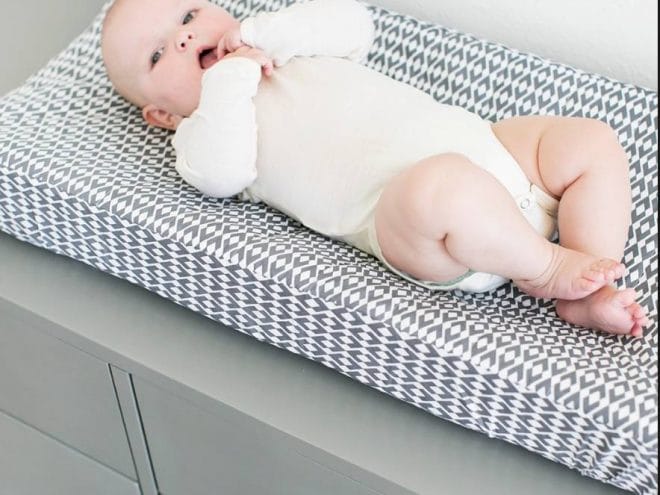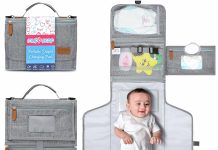When it comes to ensuring the utmost comfort for our little ones, one question often comes to mind – should we opt for thick or thin pads? Both options have their merits, but the answer all boils down to what works best for our precious babies.
In this article, we will explore the factors that influence this decision and help you make an informed choice so that your little bundle of joy stays cozy and content.
So, let’s get started on this delightful journey of discovering the perfect pads for your baby’s comfort!
Review contents
Introduction
Choosing the proper pads for a baby’s comfort is an essential decision every parent must make. The type of pads used can significantly impact the baby’s overall well-being and comfort throughout the day and night. In this article, we will explore the advantages and disadvantages of both thick and thin pads and provide recommendations for different situations. By understanding the factors to consider and comparing the comfort levels, parents can make an informed choice for their little one’s comfort.
Thick Pads
Thick pads, as the name suggests, are designed with greater thickness and padding. These pads are typically made with multiple layers of absorbent material to provide enhanced comfort and protection for the baby. The additional thickness can provide a plush feel and help cushion the baby’s delicate skin.
One advantage of using thick pads for a baby’s comfort is the increased level of cushioning they offer. The added padding can help protect the baby’s skin from discomfort caused by friction or pressure, especially during extended periods of wear. Additionally, thick pads can provide an extra layer of insulation, keeping the baby warmer in colder climates.
However, there are also disadvantages to using thick pads. One concern is the potential for increased heat retention, which may lead to excessive sweating and discomfort for the baby, especially in warmer environments. Thick pads can also be bulkier, making it more challenging to achieve a trim fit and potentially limiting the baby’s mobility. It is essential to balance the benefits of cushioning with the potential drawbacks when considering thick pads for a baby’s comfort.
Thick pads are recommended when extra cushioning and protection are desired. For example, thick pads can provide added comfort and peace of mind during overnight use or extended periods of travel. The extra padding can also help alleviate irritation and provide a soothing barrier between the skin and the diaper for babies with sensitive skin or those prone to diaper rashes.
When looking for thick pads, there are some standard features to consider. Look for pads with good absorbency and leakage control to ensure the baby stays dry and comfortable. Softness is also essential, as it helps prevent chafing and irritation. Consider pads with adjustable tabs or fasteners for a secure and customizable fit. Finally, opt for pads made from breathable materials to promote air circulation and prevent excessive heat build-up.
Thin Pads
In contrast to thick pads, thin pads are designed to be lightweight and provide minimal bulk. These pads are often made with thinner layers of absorbent material and are ideal for parents who prefer a more streamlined and less restrictive option for their baby’s comfort.
One significant advantage of using thin pads is the increased flexibility and freedom of movement they offer to the baby. The thin profile allows for a more natural fit, enabling the baby to move their legs comfortably without restrictions. Thin pads also tend to be more breathable, allowing air to circulate and reducing the risk of overheating. This can be particularly beneficial in warmer climates or during active playtime.
However, there are some disadvantages to using thin pads as well. One concern is their reduced cushioning and padding compared to thicker options. Thin pads may not provide as much protection against friction or pressure, which could lead to discomfort or irritation, especially during long periods of wear. Thin pads may also have absorbency and leakage control limitations, requiring more frequent changes to maintain the baby’s comfort.
Thin pads are recommended for situations where mobility and breathability are prioritized. For babies on the move or enjoying an active lifestyle, thin pads can provide the necessary flexibility and comfort to support their movements. Thin pads are also suitable for use in warmer environments, as they allow for better air circulation and help prevent excessive sweating.
When choosing thin pads, look for options that offer sufficient absorption and leakage control to keep the baby dry and comfortable throughout the day. Breathability is crucial, so consider pads made from materials that allow for good airflow and heat dissipation. Softness is still essential, even with thinner pads, as it helps prevent any potential chafing or irritation. Finally, consider pads with a trim fit and adjustable features to ensure a secure and comfortable fit for the baby.
Factors to Consider
There are several factors to consider when deciding between thick and thin pads. These factors will help parents make an informed choice that considers the baby’s needs and preferences.
- Baby’s age and developmental stage: The age and developmental stage of the baby can influence the suitability of thick or thin pads. Newborns and younger babies may benefit from the extra cushioning and protection thick pads provide. In comparison, older babies who are more active may prefer the flexibility and freedom of movement offered by thin pads.
- Baby’s skin sensitivity: Some babies have more sensitive skin than others and may be more prone to rashes or irritation. Choosing pads that are gentle on the baby’s skin and minimize the risk of discomfort or allergic reactions is essential.
- Climate and environment: The climate and environment in which the baby will wear the pads should be considered. In warmer climates, thin pads with good breathability can help prevent overheating and excessive sweating. In colder environments, thick pads may provide extra insulation and warmth.
- Activity level and mobility of the baby: Consider the baby’s activity level and mobility when choosing between thick and thin pads. If the baby is highly active or constantly moving, thin pads may be more suitable as they offer greater flexibility and a less restrictive feel.
- Diaper rash prevention: If the baby is prone to diaper rash or has sensitive skin, choosing between thick and thin pads becomes even more critical. Thick pads can provide a protective barrier and help alleviate irritation, while thin pads with good breathability can minimize the risk of moisture-related skin issues.
- The breathability of the pads: Regardless of thickness, choosing pads that promote good air circulation and breathability is crucial. This helps prevent heat build-up, excessive sweating, and moisture-related discomfort for the baby.
Comparing Comfort
When comparing the comfort levels of thick and thin pads, several factors come into play. Evaluating these factors can help parents determine which pad type would be the most comfortable choice for their baby.
- Softness and cushioning: Thick pads generally provide a higher level of softness and cushioning due to their added padding. This can help prevent friction and provide a more comfortable experience for the baby. However, some thin pads are also made with soft and gentle materials that ensure a comfortable fit.
- Absorption and leakage control: The ability of a pad to absorb and contain moisture is vital for the baby’s comfort. Thick pads often have a higher absorbency capacity, making them suitable for longer durations without changing. Thin pads may require more frequent changes due to their lower absorption capabilities.
- Air circulation and breathability: Both thick and thin pads can be designed with good breathability. However, thin pads typically offer better airflow due to their lighter construction and thinner layers. This can help prevent sweating and discomfort caused by heat build-up.
- Moisture-wicking properties: Moisture-wicking pads draw moisture away from the baby’s skin, keeping them dry and comfortable. Some thin pads are engineered explicitly with moisture-wicking properties, providing comfort during wear.
- Sensitivity and allergies: Sensitivity or allergies to certain materials should be considered when choosing pads for the baby’s comfort. Avoid pads made from materials the baby may be allergic to or cause irritation.
Practical Considerations
In addition to comfort, there are practical considerations that parents should keep in mind when selecting pads for their baby’s comfort.
- Cost-effectiveness: Consider the pads’ cost-effectiveness, considering the frequency of use and the need for additional accessories such as inserts or boosters. Evaluate the price per unit and the expected lifespan of the pads to determine their overall value.
- Ease of use and convenience: Look for pads that are easy to use and provide convenience in fastening and adjusting. Pads with adjustable features and easy-to-use closures can make changing diapers quicker and more straightforward.
- Available sizes and options: Ensure the pads are available in sizes that fit the baby comfortably. Additionally, having various options in terms of colors or patterns can add a touch of personalization and fun to the diapering experience.
- Compatibility with different diaper types: Consider the diaper type and ensure the pads are compatible. Some diapers may have specific insert or booster requirements, so choosing pads that work well with the selected diapering system is essential.
- Washing and care instructions: Pay attention to the washing and care instructions provided with the pads. Choose pads that are easy to clean and maintain to ensure their longevity and overall hygiene.
Expert Recommendations
To gain further insights into the topic, it is valuable to consider the recommendations and opinions of experts in baby care.
- Pediatricians’ opinions on thick vs. thin pads: Pediatricians generally emphasize the importance of comfort and breathability in selecting pads for a baby’s comfort. They often recommend using thin pads with good absorbency and breathability, particularly for babies more active or prone to skin rashes.
- Insights from baby care specialists: Baby care specialists often highlight the significance of finding a pad that balances comfort and functionality. They recommend considering the baby’s age, activity level, and skin sensitivity when deciding between thick and thin pads.
- Research studies and findings: Several studies have been conducted to evaluate the impact of different pads on a baby’s comfort. These studies often conclude that thin pads with good breathability and softness provide a higher level of comfort overall.
- Consumer reviews and feedback: Listening to the experiences and feedback of other parents can also provide valuable insights into the comfort levels of different pads. Online reviews and testimonials can help identify popular brands and models that have been positively reviewed for their baby comfort features.
Conclusion
In conclusion, choosing between thick and thin pads for a baby’s comfort depends on various factors, including age, skin sensitivity, climate, and activity level. Thick pads offer enhanced cushioning and protection but may be bulkier and less breathable.
Conversely, thin pads provide a streamlined fit and better airflow while sacrificing some cushioning. Evaluating the comfort factors such as softness, absorption, breathability, and moisture-wicking properties can help parents make an informed decision.
Balancing practical considerations such as cost-effectiveness, ease of use, and compatibility with diaper types is also essential. Parents can choose suitable pads for their baby’s comfort by considering expert recommendations and researching consumer reviews.
Additional Tips
While choosing between thick and thin pads, here are some additional tips to keep in mind:
- Keep an eye on the baby’s comfort cues: Observe the baby’s behavior, such as excessive squirming or fussiness, which may indicate discomfort. Adjusting the thickness or type of pad based on their comfort cues can help ensure a pleasant and comfortable experience.
- Experiment with different pad thicknesses: Every baby is unique, and what works for one may not work for another. If unsure, try using thick and thin pads to determine which type provides the best comfort for the baby.
- Consider individual preferences: Some babies may prefer thicker or thinner pads. Consider the baby’s reactions and comfort when making the final decision.
- Monitor and address any discomfort or issues: Pay attention to any signs of discomfort, irritation, or allergic reactions arising from using specific pads. Addressing these issues promptly by switching to a different pad or consulting a healthcare professional can help maintain the baby’s comfort and well-being.
Safety and Health Considerations
While choosing pads for a baby’s comfort, it is crucial to prioritize their safety and health. Here are some safety considerations to keep in mind:
- Importance of proper pad fit: Ensure the pad fits snugly and securely inside the diaper. A loose-fitting pad can become a suffocation hazard, while an overly tight pad can cause discomfort and restrict movement.
- Avoid excessive padding that can cause suffocation: Never use excessive padding or add additional layers to the baby’s diaper. Over-padded diapers can increase the risk of suffocation or interfere with the baby’s breathing.
- Choosing materials and brands with safety certifications: Look for pads made from materials that have been tested and certified as safe for babies. Check for certifications such as Oeko-Tex Standard 100, which ensures the materials are free from harmful substances.
- Proper hygiene practices: Follow proper hygiene practices when using and changing pads. Regularly change the baby’s diaper to prevent the accumulation of moisture and bacteria that can cause discomfort or skin issues.
- Signs of irritation or allergic reactions: Be vigilant for any signs of skin irritation, redness, rashes, or allergic reactions. If symptoms occur, discontinue using the pads and consult a healthcare professional for further guidance.
By considering these safety guidelines, parents can ensure that the pads they choose prioritize their baby’s safety and overall well-being.






























